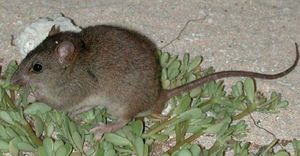Bramble Cay melomys


The Bramble Cay melomys of Queensland, Australia is the world's first mammal thought to have gone extinct due to the impacts of anthropogenic climate change. The root cause of the extinction of these rodents was repeated ocean inundation of the cay, due to sea level rise from frequent extreme weather events. The seawater floods destroyed vegetation and habitat, and probably killed some of the Bramble Cay melomys directly.[3]
Description
The Bramble Cay melomys was a species of mosaic tailed rat, distinguishable from other species of rat by the mosaic pattern of scales on its tail. The rodents were dependent on the cay's vegetation for food and shelter, heavily relying on the succulent Portulaca oleracea and possibly turtle eggs for food. The Bramble Cay melomys were the only endemic mammal species of the Great Barrier Reef, and were the most isolated and restricted mammal in Australia.[3]
Habitat
The Bramble Cay melomys were only found on Bramble Cay, located at the northern tip of the Great Barrier Reef and in the north-east Torres Strait, Queensland. Bramble Cay is a small coral cay which is approximately 340 m long by 150 m wide, and has a maximum elevation of 3 m above sea level. The cay experiences constant changes in shape, size, and orientation due to the constant erosion and deposition of material by waves, tides, and wind.[3] A small coral reef surrounds Bramble Cay and is relatively isolated from the Torres Strait's other reefs, isolating the Bramble Cay melomys. The sand cay is covered in low herbaceous vegetation which grows up to 40 cm high. The cay is home to a considerable number of seabirds, including noddies, terns, and boobies, and supports the region's only large seabird colony. Bramble Cay supports the Torres Strait's largest green turtle nesting site as well.[4]
Decline in Population
A steady decline in the population of the Bramble Cay melomys was observed over a number of years. When the Bramble Cay melomys were first discovered in 1845 by Europeans, the rodents had an extensive population. Seamen aboard the HMS Bramble entertained themselves by shooting arrows at "large rats" on the cay. Several hundred Bramble Cay melomys were estimated to occupy the cay in 1978. In 1998, the population size was estimated to be 93. By 2002 and 2004, surveys indicated that there were only 10 and 12 individuals on the cay, respectively. The last known siting of the Bramble Cay melomys was reported to be in 2009 by a fisherman who visited the island annually, suggesting that the rodents survived in low numbers until 2009.[3] In 2011, 2012, and 2014, surveys were conducted on Bramble Cay and failed to record any Bramble Cay melomys. The surveys in 2014 confirmed that the Bramble Cay melomys were no longer present on the cay.[4]
Cause of extinction
Ultimately, evidence indicates that the root cause of the the extinction of the species from Bramble Cay was human-induced climate change.[3] Anthropogenic climate change is causing a rise in the global mean temperature, rising sea level, and the frequency and intensity of weather events.[4] The resulting storms and high water levels caused repeated ocean inundation of the cay.[3] As the cay is only 3 m above sea level, seawater flooding killed or damaged vegetation[5] causing a 97% decline in vegetation observed between 2004 and 2014.[4] This observed decline in vegetation corresponds with the observed decline in population, as the species heavily relied on the vegetation for food and shelter.
Extinction status
The Bramble Cay melomys are listed as extinct in Queensland and nationally listed as endangered.[5] The pronouncement of the extinction of the species in Australia has been supported by fully comprehensive surveys conducted on Bramble Cay and other Torres Strait and Great Barrier Reef islands, which have failed to observe any of the rodents.[3] However, it is recommended that other locations should be survey as there is a possibility that the Bramble Cay melomys are still alive in the Fly River delta of Papua New Guinea. Although researchers are almost certain that the species is extinct from Australia, they may be alive in other locations so the species has yet to be declared extinct globally.[5]
References
- ↑ Wikimedia Commons [Online], Available: https://commons.wikimedia.org/wiki/File:Bramble-cay-melomys.jpg
- ↑ Australian Geographic, “Bramble Cay melomys.” [Online]. Available: http://www.australiangeographic.com.au/blogs/australian-endangered-species/2014/06/endangered-species-bramble-cay-melomys-rat. [Accessed: 07-Feb-2018].
- ↑ 3.0 3.1 3.2 3.3 3.4 3.5 3.6 Gynther, I., Waller, N. & Leung, L.K.-P. "Confirmation of the extinction of the Bramble Cay melomys Melomys rubicola on Bramble Cay, Torres Strait: results and conclusions from a comprehensive survey in August-September 2014". Unpublished report to the Department of Environment and Heritage Protection, Queensland Government, Brisbane, 2016. [Online]. Available: https://www.ehp.qld.gov.au/wildlife/threatened-species/documents/bramble-cay-melomys-survey-report.pdf. [Accessed: 07-Feb-2018].
- ↑ 4.0 4.1 4.2 4.3 Australian Government, “Melomys rubicola - Bramble Cay Melomys.” [Online]. Availble: http://www.environment.gov.au/cgi-bin/sprat/public/publicspecies.pl?taxon_id=64477. [Accessed: 07-Feb-2018].
- ↑ 5.0 5.1 5.2 Queensland Government, “Bramble Cay melomys.” [Online]. Available: https://www.ehp.qld.gov.au/wildlife/threatened-species/endangered/endangered-animals/bramble_cay_melomys.html. [Accessed: 07-Feb-2018].

